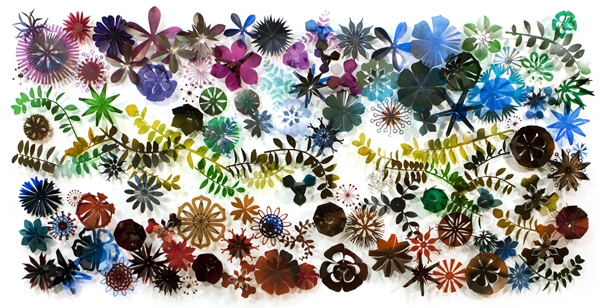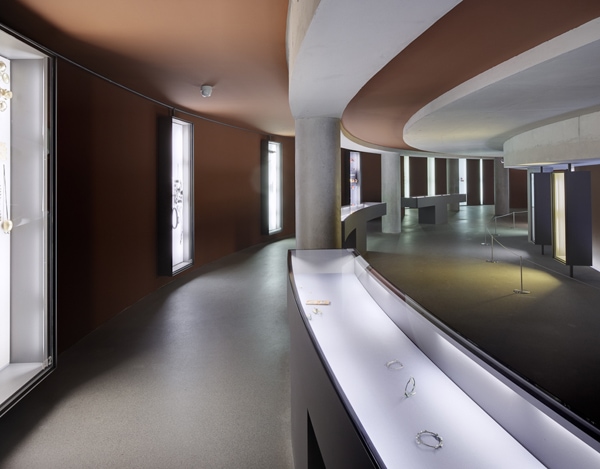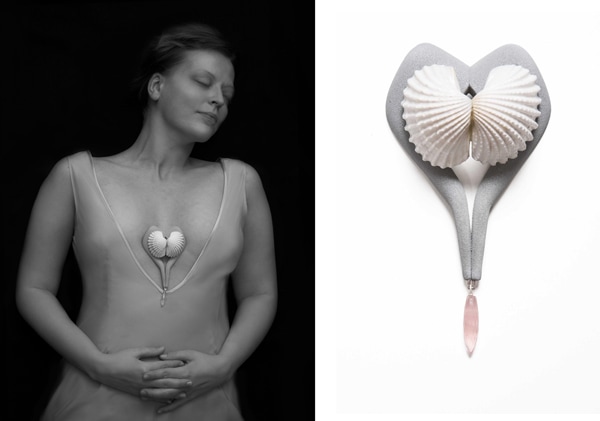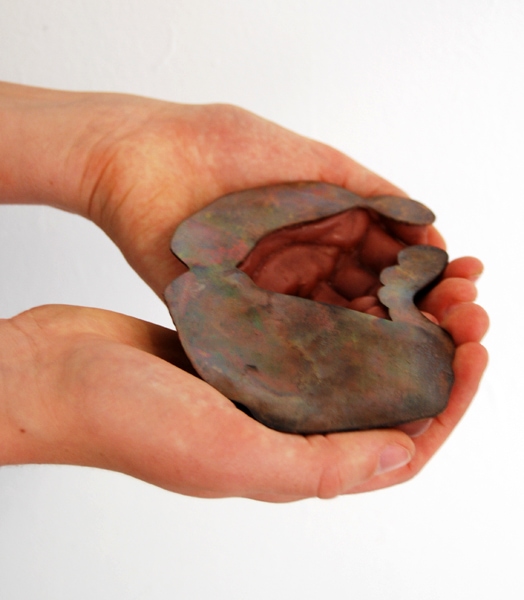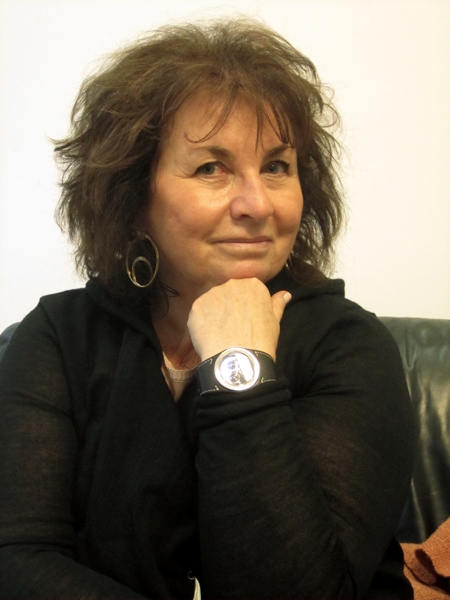In 2011, I had the opportunity to meet French collector Clo Fleiss in Paris, thanks to an introduction from Benjamin Lignel, jeweler and member of La Garantie, an association for the promotion of French contemporary jewelry. Clo Fleiss is married to a well-known dealer in Paris who specializes in blue-chip modern art. Perhaps not surprisingly, her collection focuses on what’s known as artist-designed jewelry—jewelry designed by fine artists as opposed to art jewelry or contemporary jewelry, which is part of the studio craft movement. This interview took place in a cafe just down the road from Clo’s husband’s gallery. We spoke in a mixture of English and French with Benjamin Lignel kindly translating the passages in French. Clo Fleiss’s collection has been published in two catalogs. The first, Bijoux d’Artistes, was published in 2009 and the second, Bodyguard, in 2010. I began recording our conversation while we were discussing these publications.
Damian Skinner: How long have you been collecting jewelry?
Clo Fleiss: Since 1990.
And why did you start?
Clo Fleiss: I always like to collect. I used to collect jewelry from the 1930s Art Deco to very modern work. Eventually, I started to sell it because I had enough, and I started to collect jewelry by artists. The first one was Niki Saint-Phalle. This one.
Right. The snake.
Clo Fleiss: It was made for La Société des Amis du Musée Pompidou (Society of Friends of the Museum Pompidou). And this piece was the last one. It belonged to Niki Saint-Phalle herself.
So you collect jewelry made by artists.
Clo Fleiss: Yes.
You collect work by artists from all over the world?
Clo Fleiss: All over the world. And when I started, I did not start very slowly. My husband and I were impatient when we started the collection. Act fast! Buy one a week or every two weeks! I had no thought to exhibit the jewelry. I collected it so I could wear it, not to put it on show. Later, museums began asking me if they could exhibit the jewelry because of pieces like this one by Meret Oppenheim. I think she made three bracelets. This one was from Aube Breton, the daughter of Andre Breton. So, this one is very well known, and everybody wants to borrow it.
Meret Oppenheim is famous for the fur cup and saucer.
Clo Fleiss: Yes.
Where do you buy the jewelry?
Clo Fleiss: First, I bought it at auction. Because my husband is an art dealer, we receive all the catalogs. Very often, mixed in among the paintings, auction houses sell jewelry by artists, too. And once people knew I was a collector, they started to call me, and artists started to call me, and they started to make pieces for me.
So, people begin to come to you. You don’t have to go to them.
Clo Fleiss: Yes, eventually I did not have to look. People came to me.
What do you like about this jewelry? Why do you collect it?
Clo Fleiss: Because it’s completely different. It’s not jewelry as everybody knows it. It’s not like jewelry from one of the big jewelry houses on Place Vendome where you can walk in and buy something. This is completely different. You have something very personal and unique.
Do the artists make the jewelry, or do other people make it for them?
Clo Fleiss: Few are made by the artists. Alexander Calder made all of his jewelry, but most are designed by the artist and made by a goldsmith, primarily in Italy.
Do the artists decide to do this themselves, or do people approach them to make jewelry?
Clo Fleiss: Some decide to have it made for a wife, mistress, or special friend. Picasso first designed something for his wife, and then he decided to make it a business.
I think my oldest piece of jewelry is by Julio Gonzalez and dated 1938. It was very fashionable at that time. Artists such as Picasso made jewelry, but they stopped because women didn’t like to wear it very much. Only a few women would actually wear this style of jewelry. Women would prefer to wear a big diamond or ruby or something like that. Artist-designed jewelry fell out of fashion, and then became fashionable again when I started to collect. Artists also started to make it again. But I bought a lot from the 1940s, 1950s—every period.
Of your collection, how many would be older pieces, and how many would be newer pieces?
Clo Fleiss: 180 out of 500 are older pieces, made before the 1960s.
Do you know of other collectors of artist jewelry?
Clo Fleiss: Oh, yes.
How many are there?
Clo Fleiss: When I started collecting, I influenced some friends. When I started to buy, people would propose two or three pieces from artists, but I couldn’t buy that many. I’d buy one, and then I’d call my friend and he’d have to buy one. I’m the only collector in Paris with 500 pieces. There are maybe 10 collectors in Paris with 100 to 200 pieces. In America it’s different. You can get a very large collection.
A lot of the artists seem to make their work in editions.
Clo Fleiss: Usually, it’s an edition of 20. Some make 50 or more, but some make eight.
What makes it valuable, the name of the artist or the size of the edition?
Clo Fleiss: The name of the artist.
So, Picasso’s work is going to be worth more than other artists?
Clo Fleiss: Yes, of course Picasso. The most expensive is Alexander Calder.
Why is that?
Clo Fleiss: Probably because Calder made it himself. But if someone less famous made the piece, the price would stay at the not-so-famous level. The work of Jacqueline de Jong, for example, is priced only on her artistic excellence, not on her name. If a piece was made by Andre Breton, it would cost a fortune!
At what point did you realize that you were a collector, as opposed to just buying jewelry by artists for yourself?
Clo Fleiss: First of all, I don’t want to be a collector. I want to buy artist jewelry because I like it, I want to wear it, and I want to be different from all of the women who wear diamonds. I’m in the art world. It’s very funny that when I go to the vernissage (exhibition preview) the first thing the men and women say to me is, “What are you wearing today? Who is the artist?” It’s become like that.
Do you ever buy a piece of jewelry because it relates to something else in your collection or because you don’t have anything by that artist and feel you should buy something?
Clo Fleiss: No. There is no logic for me. If I was shown a Calder piece from a period I don’t own and I know that the piece is important but I don’t like it, then I am not going to buy it.
When I started buying, the jewelry was not as expensive as it is now. I got pieces for nothing. I could not buy them now because the prices are completely crazy. I would love to buy Calder’s jewelry. I would love to buy 10, 20 pieces, but it’s impossible.
You started buying in 1990?
Clo Fleiss: Yes.
So, in the past 20 years, prices have changed entirely.
Clo Fleiss: Incredibly.
Do you wear everything that you own?
Clo Fleiss: Nearly.
What don’t you wear?
Clo Fleiss: I don’t wear some of the pieces artists made for me because I don’t like them very much. Some are too enormous.
Do you have special furniture for the jewelry?
Clo Fleiss: I used to put some pieces in a shoebox in the safe. Some are gold. For the little ones, rings and brooches, I use a small cabinet. I’ve bought various things, including a dentist cabinet. When I bought that it still smelled of formaldehyde! I’m not precious. They all sort of tangle up together. I’m not particular about how they’re laid out. I don’t really worry about wearing them and taking special care when I wear them. I wear them as if they are costume jewelry.
A number of museums want to show my collection and to borrow pieces. After participating in two exhibitions and taking out insurance to exhibit the jewelry, I realized that the jewelry costs a fortune, and so I don’t like to wear it anymore. It’s in a safe. I’m not afraid of it being stolen because no one would steal this. Most of the work just looks like metal. But I am afraid of loosing or damaging the jewelry when I wear it.
So the fact that it is made by artists and the fact that it is jewelry actually conflicts with each other. You can’t wear it because it is so valuable.
Clo Fleiss: It’s frightening. Exhibiting the collection twice has actually slowed my willingness to collect. Sometimes the desire kicks back in, but I have less interest in expensive work. I don’t want to wear it anymore unless it’s a special occasion.
So you stopped?
Clo Fleiss: I did not stop. I just prefer to go for the younger people, the contemporary jewelers or designers.
It’s almost like the collection turned back into art as opposed to being jewelry for you. At first you could wear the jewelry, and then they became art works and you can’t wear them.
Clo Fleiss: Yes. It was jewelry first, very different jewelry, but when I had it insured, it was like an electroshock in my head. Often, museums from around the world call me and ask if I want to exhibit my collection. I say, “No. I stopped. It’s finished.”
What are you going to do with your collection?
Clo Fleiss: I don’t know. I want to sell it, but my husband doesn’t want to, and my daughter and son don’t want me to sell. I could sell now. Really, I could. I’m a crazy collector. When I stop, I sell, and I start again. So, I could sell it. I don’t think it would be sad.
In other instances when you’ve stopped collecting something and sold it, did you have a similar experience? Did something happen to make you think you don’t want to continue collecting these objects?
Clo Fleiss: I’ve started every collection when the objects were cheap and nobody was collecting them. It’s not fun to collect things that are expensive. It’s easy to go in a shop and say, “I want this, this, and this.” To buy something expensive in a gallery is easy. It’s a question of money. But, to find something and hunt it down—there’s a commitment. When I see Calder in a catalog, I would love to buy it because it is so beautiful, but it’s impossible. It’s not for me. It’s for a rich American, but not for me. The price is too high now.
Do most collectors of artist jewelry wear their collections?
Clo Fleiss: Yes, like me, they wear it.
Do you have special emotional investment in these pieces, and does the fact they are made by artists affect that investment?
Clo Fleiss: Of course. It’s very emotional to wear a piece that’s made by a very famous artist.
Some of your jewelry has been made for you or given to you by the artists themselves. How did that come about?
Clo Fleiss: The artists know I have a jewelry collection, and they ask if I would be pleased if they made a piece for me. And I say, “Okay.” Sometimes I ask the artist. I say to them, “Would you like to make me something to go to my collection?” and they agree with pleasure.
Artists respond well to that sort of request?
Clo Fleiss: Oh, yes. All of them. And sometimes when I ask, it gives them the idea to commercially produce the piece of jewelry.
How does the art world view this kind of jewelry? Is it the same as the other art that the person makes, or is it treated slightly differently?
Clo Fleiss: No, it’s not as expensive as painting or sculpture, but it’s very well known.
Why do you think it is valued differently?
Clo Fleiss: Because it’s jewelry. At the beginning, it was not a very serious activity for a painter or sculptor. It was something playful.
Looking through the catalogs, it appears that you have become more experimental than the market, because the market would prioritize famous artists, but you’ve become interested in interesting jewelry.
Clo Fleiss: Yes. I have started to choose jewelry that is more effective. For example, Frederica Matta is the daughter of Roberto Matta. This woman is not very well known, but her work is very interesting.
In the end, it doesn’t have to be a famous artist, but it has to be an interesting piece of jewelry.
Clo Fleiss: Yes, exactly. I have pieces where I don’t even know the artist. I think the work is interesting, but there is no value. But you know, when they have an exhibition in a museum, the curators have to choose a big name. If they feature a minor name, then nobody will go to the museum, so they have to include a big name.
When I started collecting, it was only artist jewelry. Later, I saw so many beautiful things made by jewelry designers, but the majority of my collection is artist jewelry. First, the artist was more important because my husband is an art dealer. But after I saw so many beautiful things, I said why not?
Part 2
After our first interview took place, the collection was shown again, for the third time, at the Crédit Municipal de Paris (October 8, 2012 to January 8, 2013). This institution was founded in 1637 to emulate the Italian Monte di Pietà. It is a state run pawnshop located in the center of Paris in an ancient private hotel across from the old public library. Like any pawnshop, Crédit Municipal de Paris takes collateral, mostly in gold and silver, for the money they lend. Unlike most pawnshops, they have a 92-percent re-acquisition rate and a policy to remainder whatever profit they might make on resale back to the depositor. This made for an oddly appropriate new setting for Clo Fleiss’s exhibition and seemed to justify having another chat with her. Emmanuel Guigon, director of the Musée du Temps in Besançon, curated the first and last exhibitions of Clo Fleiss’s collection. His comments were submitted by email and incorporated into this second interview.
What prompted you to exhibit your collection at the Crédit Municipal de Paris? How was the deal brokered?
Clo Fleiss: The Crédit Municipal approached me. They saw the exhibition of my collection in Besançon, called the museum director Emmanuel Guigon, and asked if I would be willing to lend them the work. They opened this exhibition space very recently. Bijoux d’artiste is only the second show they’ve hosted.
It is an unusual place to exhibit jewelry, isn’t it?
Clo Fleiss: Emmanuel Guigon thought the link between a pawning institution and a jewelry exhibition interesting, as did I. The place is also called “My Aunt” after some heir to the throne who gave up his watch to the Crédit Municipal. He told his mother, the queen, that he had left the watch at his aunt’s. There is something shameful about pawning. Some artists exhibited in the show did not like the link between a pawnshop and jewelry. But, other artists understood, like one of them who had to re-melt some work to pay the bills. It was OK for them.
The exhibition seems to be a tighter selection than the previous ones? Is that the case? Who made that choice?
Clo Fleiss: There are about 160 pieces in the current show—about a dozen more than in the first exhibition at the museum of time in Besançon but 50 less than in the second exhibition, which took place in 2010 at the Passage de Retz, a commercial gallery in Paris. We decided to show only artists in this final exhibit, no designers or contemporary jewelers. Curator Emmanuel Guigon and I met with the people of the Crédit Municipal. He brought in the scenographer and the lighting designer. We selected the jewelry together.
Do you feel that each exhibition was a reinterpretation of your collection or that it revealed a different aspect of it?
Emmanuel Guigon: In Besançon, the exhibition took place under the eaves of a magnificent Renaissance palazzo in a large room that looks like the upturned hull of a boat. Because of this analogy with traveling, I wanted to occupy that space and give it a meaning by creating a series of waves, literally. The display platforms were undulated like waves. Depending on their size, the jewelry showcases were islands or islets of sorts. They let the visitor travel across different jewelry “time zones,” starting with the pioneers—Gonzalez, Manolo, Hugue—then the surrealists, the kinetics, etc.
In Paris, the room is smaller, badly lit, has a lower ceiling, and the space is interrupted by an excessive number of square columns. We wanted to use the columns to create the scenography, girdling them not with waves but with cloud shaped platforms that would make the space more ethereal and less heavy. We also had to create some rhythm between these showcases, all of different heights and sizes, to create interesting viewpoints from wherever you stood in the small space.
Clo Fleiss: The first and the last exhibition are not very different. Emmanuel Guigon is a conservator and favored historical pieces. Also, his museum in Besançon and the Crédit Municipal are public spaces, so we had to choose big names, such as Picasso and Man Ray, to attract the public. This was important for them, but not so much for me. I would have preferred younger artists. I liked both exhibition designs. The only thing I would have preferred is more showcases.
The second exhibition in the Passage de Retz was a big mistake. It was extremely laborious, and the team there was very badly organized. They did not have a pedestal maker or a light specialist. Really, they had no means. In the end, I had to sort out most things myself, and it cost me a lot. Also, the catalogue is really poorly put together. It falls apart as soon as you touch it. But that show included designers, contemporary jewelers, and minor artists, and I really liked that. The show was more complete, more representative of my collection, and much bigger. The scenographer was a Brazilian woman from the Musée d’Orsay, and it was really beautiful.
Some of the cases seemed to have been arranged to encourage “conversations” between pieces—pairing artists within the same artistic movement, but also more interestingly, artists from different generations with formal affinities. How did this come about?
Clo Fleiss: This is the work of Emmanuel. He made the selection and put Picasso with Derain and Niki de St Phalle with César and Hains. Sometimes, I convinced him to change something, place a piece into one cabinet instead of another, but mostly the layout was his responsibility.
Emmanuel Guigon: The selection for each showcase was essentially dictated by periods, schools, or a shared fascination of similar forms, such as Dubuffet’s and Hare’s taste for brut and primitivisms. Some artists were linked because they worked with the same designer— Barceló and Bourgeois worked with Chus Burres. Sometimes it was dictated by the restricted height of the showcases. Sometimes, a small showcase lets you isolate, and therefore see better, an extraordinary object such as the piece Eduardo Arroyo made for Clo.
Has your perception of jewelry changed since you began collecting 20 years ago?
Clo Fleiss: The current fad for artist jewelry really annoys me. It is in fashion, a bit like contemporary art, with prices going through the roof. Galleries are opening for artist jewelry. I know of three that just opened in Paris. Galerie miniMasterpieces on rue des St Peres is one example. And so I continue to collect, because I cannot resist, but mostly designer or contemporary jewelry. They are much cheaper. I love Naila de Monbrison. She was the very first one to sell artist jewelry, but now she is selling contemporary jewelry, too.
Last time we met, you said you were not interested in exhibiting your collection again. Yet one year after, you did. Are you still “not going to exhibit it again?”
Clo Fleiss: Well, it’s a lot of work and I don’t really want to do it again—but if the Prada Foundation in Venice asked me, I might be tempted!
 Charon Kransen Arts is a gallery and bookstore located on the Upper West Side of New York City. Their show schedule consists of a regular series of fairs. Charon Kransen Arts recently organized an exhibit for Art Palm Beach (January 24–28). We took advantage of this opportunity to feature one of the artists they represent, Julia Barello. Julia got her start as a jeweler and is now doing very large installations, which is what she will show at Art Palm Beach.
Charon Kransen Arts is a gallery and bookstore located on the Upper West Side of New York City. Their show schedule consists of a regular series of fairs. Charon Kransen Arts recently organized an exhibit for Art Palm Beach (January 24–28). We took advantage of this opportunity to feature one of the artists they represent, Julia Barello. Julia got her start as a jeweler and is now doing very large installations, which is what she will show at Art Palm Beach. 